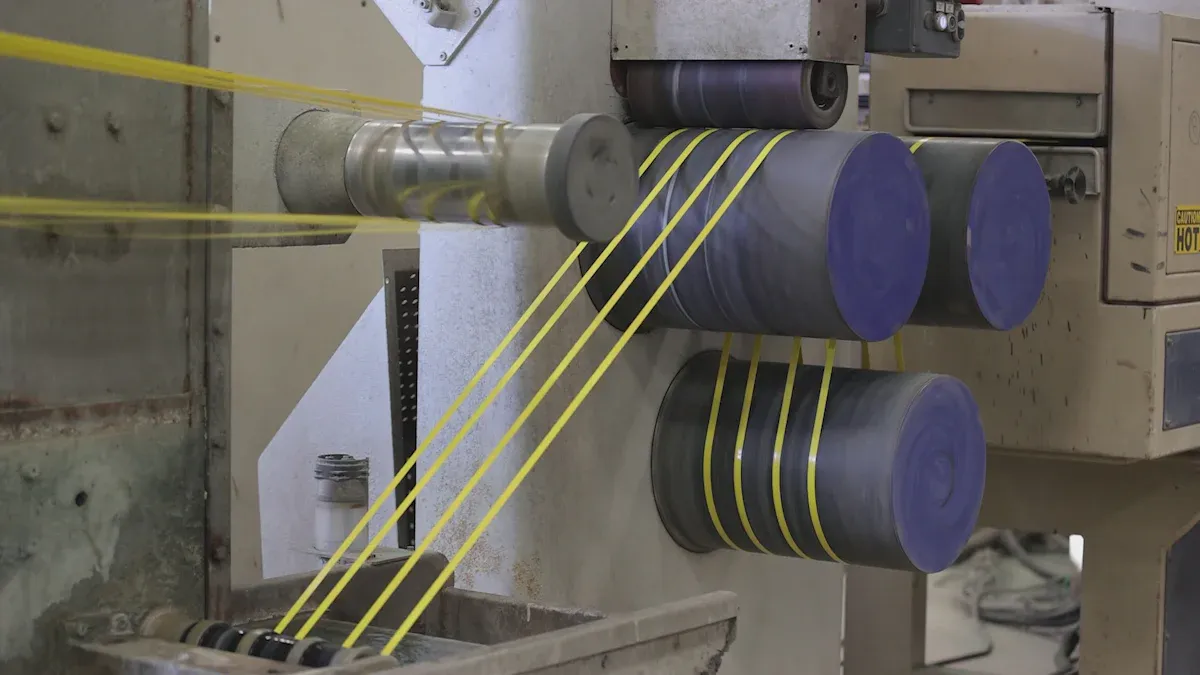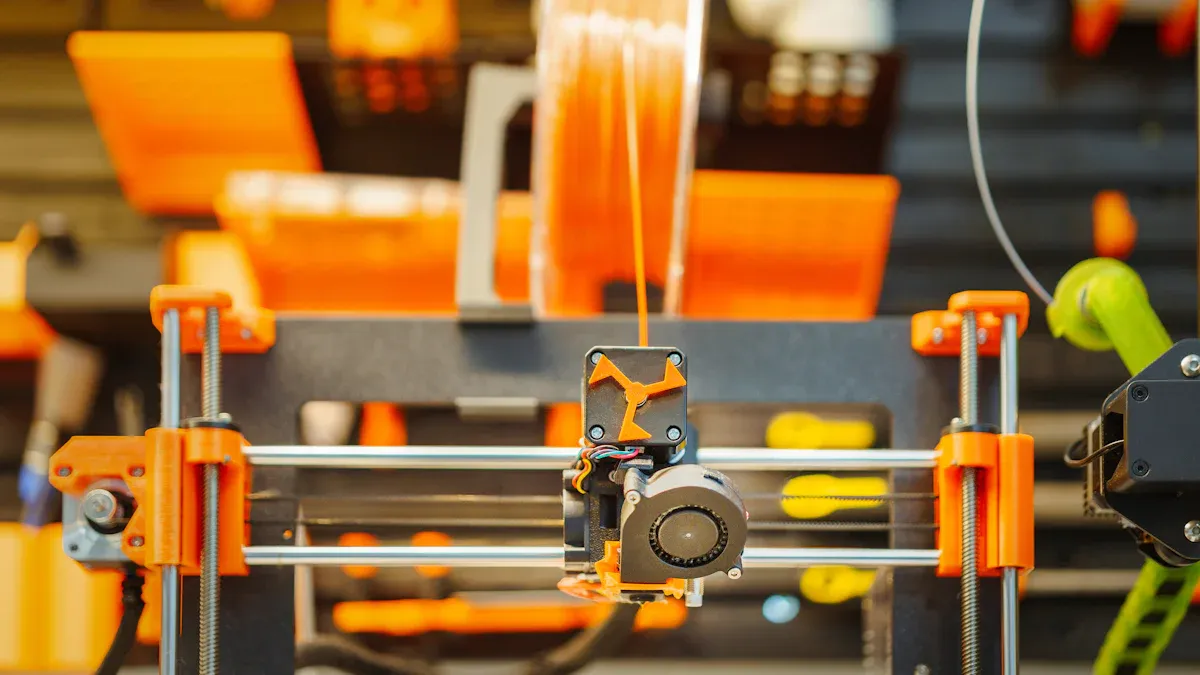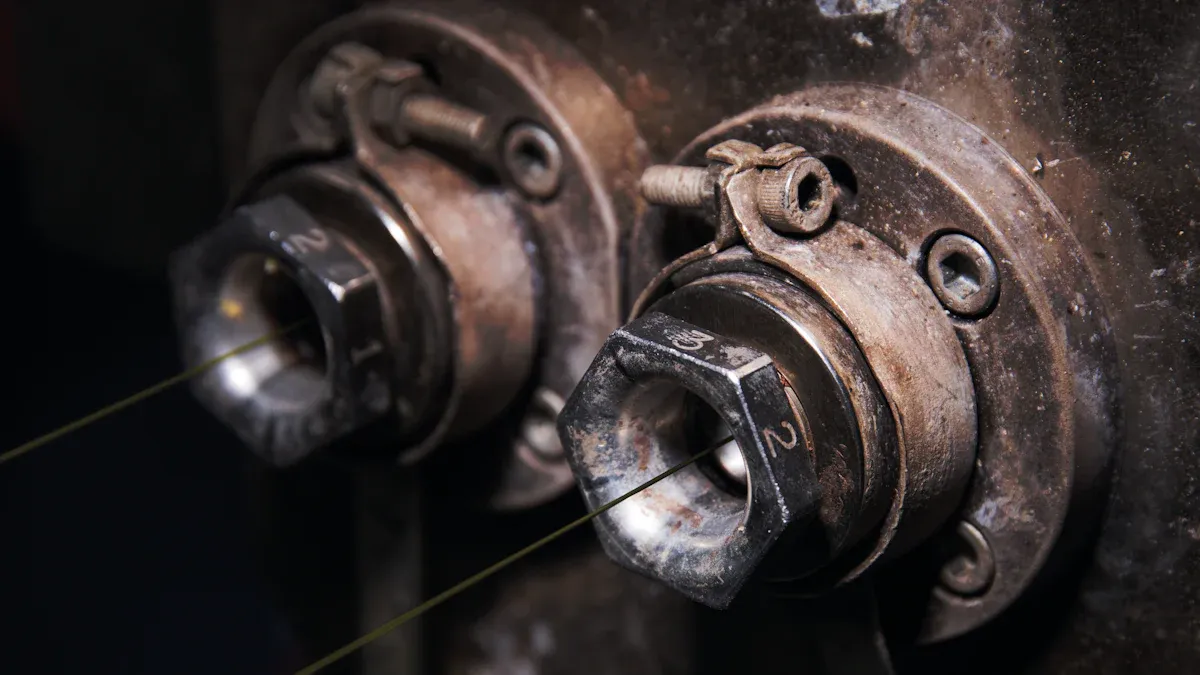Ethan
“As your dedicated Client Manager at Zhejiang Jinteng Machinery Manufacturing Co., Ltd., I leverage our 27-year legacy in precision screw and barrel manufacturing to deliver engineered solutions for your plastic and rubber machinery needs. Backed by our Zhoushan High-tech Zone facility—equipped with CNC machining centers, computer-controlled nitriding furnaces, and advanced quality monitoring systems—I ensure every component meets exacting standards for durability and performance. Partner with me to transform your production efficiency with components trusted by global industry leaders. Let’s engineer reliability together: jtscrew@zsjtjx.com.”

A laboratory single screw extruder uses a rotating screw to melt, mix, and shape polymers inside a heated barrel. Researchers rely on the vented single screw extruder, single screw machine, and waterless granulator machine to achieve optimal mixing and safe, effective processing. Studies show that screw speed and temperature directly impact product quality and safety.
Main Components of a Single Screw Extruder

The Screw
The screw is the heart of the single screw extruder. It rotates inside the barrel and moves the polymer forward. The screw melts, mixes, and pushes the material toward the die. Screw design, including diameter, length-to-diameter ratio, and compression ratio, affects how well the polymer melts and mixes. A well-designed screw improves melting rates and efficiency. Grooves on the screw or barrel can increase melting speed and help control the process. The screw speed also changes the amount of mixing and the heat generated.
Tip: Adjusting screw speed can help control the melt temperature and product quality.
The Barrel
The barrel surrounds the screw and holds the polymer as it moves. The barrel has different temperature zones. Each zone can be set to a specific temperature to help melt the polymer evenly. For example, the first zone may be cooler to help move the solid polymer, while later zones are hotter to melt the material. Proper temperature control in the barrel is important for good flow and product quality. Thermocouples measure the temperature inside the barrel to keep the process stable.
- Barrel temperature settings depend on the type of polymer and the screw design.
- Modern extruders often have three or more temperature zones.
- The feed section should be warm but not too hot to avoid material sticking.
The Heater System
The heater system keeps the barrel at the right temperature. Heaters are placed along the barrel and controlled by sensors. The system can adjust each zone to match the needs of the polymer. Good heater control helps avoid problems like material burning or uneven melting. The heater system works with the control system to keep the process safe and efficient.
The Die
The die shapes the melted polymer as it leaves the single screw extruder. Die design affects the final product’s shape, surface, and size. A good die gives a smooth, even flow and helps make products with accurate dimensions. The die must handle the right temperature and pressure to avoid defects. Changes in die temperature or flow can change the product’s quality.
- Uniform velocity and minimal pressure drop at the die exit are important for quality.
- Die channel geometry and flow balance affect the accuracy of the product shape.
The Control System
The control system manages the single screw extruder’s operation. It monitors temperature, pressure, screw speed, and feed rate. Operators use the control system to set and adjust process parameters. Real-time monitoring helps keep the process stable and safe. The control system can also store recipes for different polymers, making it easier to repeat successful runs.
Types of Single Screw Extruder for Laboratory Use
Laboratory settings require different types of extruders to meet specific research needs. Each type offers unique features and advantages for polymer processing.
Vented Single Screw Extruder
A vented single screw extruder uses a two-stage screw design. This design reduces torque and horsepower needs while maintaining output and screw speed. The venting system removes moisture and gases from the polymer melt. This step is important for processing plastics that absorb water. Removing these volatiles prevents defects such as splay and weak mechanical properties. The vent port often operates under vacuum, which helps degassing by lowering the pressure. The two-stage screw also improves mixing by compressing and decompressing the plastic. This process creates a more uniform melt. Operators must balance the output between the two stages to avoid surging or vent flooding. These features make the vented single screw extruder efficient and reliable in laboratory applications.
Note: Stable output and lower energy use set vented extruders apart in research environments.
Single Screw Machine
The single screw machine covers a wide range of extruders for melting, mixing, and shaping polymers. These machines offer simple design and easy operation. Researchers can control shear and temperature well, which helps with basic polymer formulations and extrusion tasks. Single screw machines work well for making tubing, film, and other simple products. They come in different sizes and configurations to match various research needs.
| Extruder Type | Key Features and Advantages | Typical Applications and Suitability |
|---|---|---|
| Single Screw Extruders | Simple design, good control, easy operation | Tubing, film, basic polymer formulations |
| Twin Screw Extruders | Superior mixing, versatile, intermeshing screws | Compounding, complex materials, pharmaceuticals |
| Miniature/Micro Extruders | Small-scale, cost-effective, reliable | R&D, prototyping, limited material samples |
Waterless Granulator Machine
A waterless granulator machine converts plastic materials into granules without using water. This technology improves energy efficiency and reduces environmental impact. The process keeps the granules dry and clean, which benefits further processing steps. Waterless granulator machines handle many types of plastic resins. They help researchers produce high-quality granules for testing and development.
Step-by-Step Polymer Extrusion Process

Feeding the Polymer Material
The extrusion process begins with feeding the raw polymer material into the feed hopper. The hopper ensures even distribution and prevents blockages, which helps maintain a steady throughput. The screw inside the barrel starts to rotate, pulling the polymer pellets or powder forward. The design of the screw, including its diameter and length-to-diameter ratio, plays a key role in how efficiently the material moves. The control system allows operators to adjust the screw speed and feed rate, which helps fine-tune the process for different polymers.
- Feed hoppers are designed to prevent clogs and ensure smooth feeding.
- The screw conveys, compresses, and begins to heat the polymer.
- Temperature control in the barrel helps optimize the melting process.
Early studies established that controlling screw speed and temperature directly affects how well the polymer feeds and melts. Modern laboratory extruders use advanced controls to keep feeding efficient and stable.
Melting and Plasticizing
As the polymer moves along the barrel, it enters heated zones. The temperature in each zone increases gradually, causing the polymer to soften and melt. The screw’s rotation and the barrel’s heat work together to plasticize the material, turning it into a uniform molten mass. Sensors placed along the barrel monitor both temperature and pressure to ensure the polymer melts within its ideal processing range.
| Parameter | Description |
|---|---|
| Melt Temperature | Must stay within the polymer’s processing range for best results. |
| Pressure Above the Screw | Indicates melt quality and process stability. |
| Pressure Fluctuations | Monitored to detect any issues with melting or flow. |
| Temperature Fluctuations | Tracked to ensure even heating and avoid defects. |
| Degree of Melting | Checked visually or by testing extruded film for clarity and uniformity. |
| Screw Performance Index | Combines these factors to rate melt quality from poor (0) to excellent (1). |
Precise control of temperature and pressure helps prevent degradation and ensures a consistent melt. Real-time monitoring with advanced sensors and spectroscopy techniques provides continuous data, allowing researchers to adjust settings as needed.
Mixing and Conveying
Once melted, the polymer must be mixed thoroughly to ensure uniformity. The screw design, including features like barrier sections or mixing zones, helps blend the material and remove any remaining solid fragments. As the screw rotates, it pushes the molten polymer forward, conveying it toward the die.
Researchers use advanced setups with sampling ports and optical detectors to study how well the material mixes. By injecting tracers and measuring how they spread, they can see how screw speed and geometry affect mixing. High screw speeds can sometimes leave solid fragments, but special screw designs improve mixing and prevent this issue. Pressure sensors along the barrel measure how efficiently the polymer moves, helping operators optimize the process.
Shaping Through the Die
The molten polymer reaches the die, which shapes it into the desired form. The die’s design determines the final product’s size and surface quality. Engineers use computer simulations and finite element analysis to design dies that produce accurate shapes and minimize defects. They also optimize the flow channel geometry to balance velocity and reduce molecular orientation differences, which can affect the product’s dimensions.
| Evidence Aspect | Description |
|---|---|
| Finite Element Analysis | Used to study flow and shape accuracy in the die. |
| Optimization Design | Reduces errors and improves geometric precision. |
| Experimental Validation | Confirms tight control of product dimensions. |
| Numerical Simulation | Predicts die swell and interface movement for better results. |
| Molecular Orientation Control | Balances flow to prevent uneven stretching and shape changes. |
Precise control of the die and downstream equipment ensures the product leaves the Single Screw Extruder with the correct shape and size.
Cooling and Solidifying
After shaping, the hot polymer exits the die and enters the cooling phase. Cooling solidifies the polymer, locking in its final shape and properties. The cooling rate depends on the extrusion temperature, ambient conditions, and the speed at which the product moves through the cooling zone.
| Parameter/Aspect | Observation/Result |
|---|---|
| Extrusion temperature | Polymer extruded at 100 °C |
| Ambient temperature | Maintained around 20 °C during experiments |
| Cooling rate peak temperature | About 72 °C |
| Effect of velocity | Lower velocities slow cooling and extend solidification time |
| Cooling rate behavior | Maximum rate drops as velocity decreases; peak shifts to longer times |
| Multi-layer effect | Later layers can reheat earlier ones, improving adhesion |
Maintaining cooling zones within a narrow temperature range, often within ±2°C, helps ensure consistent product quality. Proper cooling prevents warping and ensures the polymer solidifies evenly.
Applications of Single Screw Extruder in Polymer Research
Material Formulation and Testing
Researchers use laboratory extruders to develop and test new polymer blends. Foundational studies and patents describe how screw design and heat management improve melting and mixing. These improvements help scientists create new materials with specific properties. For example, a low-capacity extruder built with local materials showed strong performance in lab-scale production. It processed up to 13 kg per hour and reduced unwanted compounds in the final product. These results confirm that laboratory extruders support both innovation and quality control in material formulation.
| Parameter | Value/Outcome |
|---|---|
| Throughput | 13.0 kg/h |
| Screw Speed | 200 rpm |
| Barrel Diameter | 40 mm |
| Expansion Ratio | 1.82–2.98 |
| Trypsin Inhibitor Reduction | 61.07%–87.93% |
Process Optimization
Laboratory extruders help scientists find the best process settings for different polymers. Experimental data show that energy use depends on screw speed and material properties. By recording motor power and adjusting settings, researchers can improve energy efficiency and product quality. Studies also show that changing screw speed and adding certain ingredients can improve how polymers mix and flow. These findings help teams set up safe, efficient, and repeatable processes for both research and production.
Tip: Adjusting screw speed and temperature can balance energy use and improve product quality.
Small-Scale Product Prototyping
Lab extruders make it easy to create small batches of new products. Teams can control temperature, pressure, and screw speed for reliable results. This approach saves money and speeds up development. Researchers can quickly test new ideas and scale up successful ones. Compact extruders also allow for flexible changes in material or design. Advances in automation and real-time monitoring further improve process control and reduce waste.
- Precise control over process parameters
- Cost-effective and rapid prototyping
- Easy adaptation for different materials
- Enhanced product quality and uniformity
Operational Tips and Troubleshooting for Single Screw Extruder
Setting Up the Extruder
Proper setup ensures reliable operation and extends equipment life. Technicians follow these steps for optimal performance:
- Install screws in their original positions and test new screws at low speed before full operation.
- Calibrate temperature control instruments regularly for accurate adjustments.
- Use distilled water in the cooling tank to prevent scaling and check water levels often.
- Inspect solenoid valves and coils, replacing any faulty parts.
- Secure couplers daily and verify that heating zone relays and solenoid valves work correctly.
- Clean vacuum tanks and exhaust chambers; replace worn sealing rings as needed.
- Check DC motor brushes and protect against rust.
- Preheat gradually during startup and increase screw speed slowly.
- Lubricate moving parts and tighten fasteners regularly.
- For long-term storage, apply anti-rust grease and store screws properly.
Tip: Following these steps helps maintain product quality and equipment longevity.
Common Issues and Solutions
Operators may encounter several issues during operation. The table below outlines common problems and solutions:
| Issue Category | Common Issues | Causes | Symptoms | Solutions |
|---|---|---|---|---|
| Mechanical Failure | Screw stuck | Material buildup, poor lube | Motor overload, noise | Clean, lubricate, inspect |
| Electrical Failure | Motor failure | Overheating, short circuit | No start, overheating | Inspect system, avoid overload |
| Process Failure | Poor plasticization | Low speed, wrong temp | Rough surface, bubbles | Adjust speed, temp, material |
| Preventive Measures | Maintenance | Lack of cleaning, inspection | N/A | Schedule cleaning, inspections |
Regular inspection and maintenance prevent most issues. Operators should follow manual instructions when adjusting the extrusion die to avoid faults.
Safety Considerations
Laboratory extruder operation involves several hazards. Safety measures include:
- Wearing personal protective equipment such as safety shoes and glasses.
- Avoiding loose clothing near moving parts.
- Grounding all electrical equipment by qualified personnel.
- Keeping floors dry and using platforms or drains to prevent slips.
- Installing guards on moving parts to protect hands.
- Using starter lines for threading instead of hand feeding.
Note: Strict safety discipline reduces the risk of burns, electrical shocks, and mechanical injuries.
Laboratory extruders support safe, efficient polymer processing through precise control of temperature, pressure, and screw speed. Researchers benefit from small-batch production, reduced waste, and rapid prototyping. Modular designs enable quick changeovers and customization. Consistent practice and attention to detail help achieve reliable results and foster innovation in polymer research.
FAQ
What polymers can a laboratory single screw extruder process?
A laboratory single screw extruder can process most thermoplastics, including polyethylene, polypropylene, polystyrene, and PVC. Researchers often select materials based on project requirements.
How does venting improve polymer quality?
Venting removes moisture and gases from the polymer melt. This step prevents defects, such as bubbles or weak spots, and improves the final product’s mechanical properties.
How do operators control the extrusion temperature?
Operators set and monitor barrel temperatures using the control system. Sensors provide real-time feedback, allowing precise adjustments for consistent polymer melting and shaping.
Post time: Jul-01-2025
